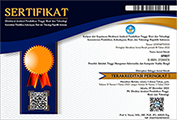KAJIAN LITERATUR CYBER SECURITY DENGAN METODE BIBLIOMETRIC PERIODE 2019 - 2025
Abstract
Seiring meningkatnya ketergantungan terhadap sistem digital dan internet, kebutuhan akan penelitian dan inovasi di bidang cyber security menjadi sangat mendesak. Adapun kajian terdahulu yang berhubungan dengan siber hanya fokus pada media atau alat bantu pembelajaran. Studi bibliometrik menjadi pendekatan yang tepat untuk memahami dinamika penelitian siber security dalam kurun waktu tersebut. Melalui analisis bibliometrik, dapat diperoleh gambaran mengenai tren publikasi (jumlah, distribusi, dan pertumbuhannya), tahun dan artikel dengan tingkat kutipan tertinggi, serta topik-topik utama yang mendominasi penelitian dalam bidang ini. negara yang menulis publikasi terbanyak tentang cyber security yaitu China berhasil menempati peringkat pertama di Asia dengan jumlah sitasi terbanyak sedangkan untuk publlikasi terbanyak ditingkat Dunia adalah United State yang kemudian disusul china. Posisi peneliti Indonesia tidak terlihat pada TOP TEN Tingkat dunia, hal ini mengindikasikan bahwa minat penelitian untuk topik cyber security sangat minim peminat. Hal ini sekaligus menunjukkan adanya celah penelitian untuk dilakukan penelitian lanjutan oleh peneliti-peneliti Indonesia.
Keywords
Full Text:
PDF hlm 86 - 97References
R. Prodanović et al., “Wireless sensor network in agriculture: Model of cyber security,” Sensors (Switzerland), vol. 20, no. 23, pp. 1–22, 2020, doi: 10.3390/s20236747.
M. Pawlicki, R. Kozik, and M. Choraś, “A survey on neural networks for (cyber-) security and (cyber-) security of neural networks,” Neurocomputing, vol. 500, pp. 1075–1087, 2022, doi: 10.1016/j.neucom.2022.06.002.
V. I. Marín and L. Castaneda, “Developing digital literacy for teaching and learning,” Handbook of open, distance and digital education. Springer, 2023. doi: 10.1007/978-981-19-2080-6_64.
S. Amanda and R. Firdaus, “Pengaruh Penerapan Smart Card terhadap Lingkungan Masyarakat,” Innov. J. Soc. Sci. …, 2024, [Online]. Available: http://j-innovative.org/index.php/Innovative/article/view/12435
H. S. Cahyadi and A. Novriyanti, “THE EFFECT OF ICT ON TOURIST EXPERIENCE IN DKI JAKARTA AS" SMART CITY",” J. Indones. Tour. …, 2020, [Online]. Available: https://ejournal.upi.edu/index.php/Jithor/article/view/24304
C. F. Anisa and B. Hidayat, “Penerapan Smart City dalam Pelaksanaan Pelayanan Publik di Kota Magelang,” Wacana Paramarta J. Ilmu Huk., 2023, [Online]. Available: http://paramarta.web.id/index.php/paramarta/article/view/241
I. D. Bulow and R. Ilmudinulloh, “Adaptasi Teknologi Informasi dan Komunikasi bagi Widyaiswara Balai Diklat Keagamaan Manado di Era Society 5.0,” Pros. PITNAS Widyaiswara, 2024, [Online]. Available: https://ejournal.iwi.or.id/ojs/index.php/pitnas2024/article/view/302
A. Affandi, “Peningkatan Literasi Teknologi IoT untuk Mendukung Implementasi Smart City di Masyarakat Perkotaan,” Merkurius J. Ris. Sist. Inf. dan Tek. …, 2024, [Online]. Available: https://journal.arteii.or.id/index.php/Merkurius/article/view/403
M. Kashif, S. A. Malik, M. T. Abdullah, M. Umair, and P. W. Khan, “A systematic review of cyber security and classification of attacks in networks,” Int. J. Adv. Comput. Sci. Appl., vol. 9, no. 6, pp. 201–207, 2018, doi: 10.14569/IJACSA.2018.090629.
F. Alqurashi and I. Ahmad, “Scientometric Analysis and Knowledge Mapping of Cybersecurity,” Int. J. Adv. Comput. Sci. Appl., vol. 15, no. 3, pp. 1177–1184, 2024, doi: 10.14569/IJACSA.2024.01503117.
T. T. Tran, D.-H. Luong, and T. Thi, “A Bibliometrics Analysis of Scopus-Indexed Research on Teachers’ Well-Being from 1995-2022: Emerging Research Trends ,” Eur. J. Educ. Res., vol. 13, no. 2, pp. 457–478, Apr. 2024, doi: 10.12973/eu-jer.13.2.457.
E. Bran, R. Rughiniș, D. Țurcanu, and A. R. Stăiculescu, “Decoding National Innovation Capacities: A Comparative Analysis of Publication Patterns in Cybersecurity, Privacy, and Blockchain,” Appl. Sci., vol. 14, no. 16, 2024, doi: 10.3390/app14167086.
A. Alsadhan, A. Alotaibi, L. Altamran, M. Almalki, M. Alfulaij, and T. Almoneef, “Manar: An arabic game-based application aimed for teaching cybersecurity using image processing,” Int. J. Adv. Comput. Sci. Appl., vol. 11, no. 10, pp. 410–416, 2020, doi: 10.14569/IJACSA.2020.0111051.
N. A. A. Rahman, I. H. Sairi, N. A. M. Zizi, and F. Khalid, “The importance of cybersecurity education in school,” Int. J. Inf. Educ. Technol., vol. 10, no. 5, pp. 378–382, 2020, doi: 10.18178/ijiet.2020.10.5.1393.
A. Alam, R. T. Ratnasari, A. Prasetyo, I. Hapnitasari, and E. Rahmawati, “Systematic Literature Review on Halal Label Studies of Halal Tourism,” vol. 13, no. 1, pp. 635–645, 2024, doi: 10.18421/TEM131.
B. D. Adelia, M. N. R. Jauhariyah, S. Mahtari, and ..., “A Bibliometric Analysis of Minimum Competency Assessment Research with VOSViewer Related to the Impact in Physics Education on 2019-2020,” J. Phys. …, 2021, doi: 10.1088/1742-6596/2110/1/012022.
M. Landauer, F. Skopik, M. Wurzenberger, and A. Rauber, “System log clustering approaches for cyber security applications: A survey,” Comput. Secur., vol. 92, 2020, doi: 10.1016/j.cose.2020.101739.
S. Ansong, W. Rankothge, S. Sadeghi, H. Mohammadian, F. B. Rashid, and A. Ghorbani, “Role of cybersecurity for a secure global communication eco-system: A comprehensive cyber risk assessment for satellite communications,” Comput. Secur., vol. 149, 2025, doi: 10.1016/j.cose.2024.104156.
S. Anawar, N. A. Zakaria, M. Z. Masu’d, Z. Muslim, N. Harum, and R. Ahmad, “IoT technological development: Prospect and implication for cyberstability,” Int. J. Adv. Comput. Sci. Appl., vol. 10, no. 2, pp. 428–437, 2019, doi: 10.14569/ijacsa.2019.0100256.
A. Golda et al., “Privacy and Security Concerns in Generative AI: A Comprehensive Survey,” IEEE Access, vol. 12, pp. 48126–48144, 2024, doi: 10.1109/ACCESS.2024.3381611.
E. Alabdulkreem et al., “Intelligent Cybersecurity Classification Using Chaos Game Optimization with Deep Learning Model,” Comput. Syst. Sci. Eng., vol. 45, no. 1, pp. 971–983, 2023, doi: 10.32604/csse.2023.030362.
S. Furnell, “Usable Cybersecurity: a Contradiction in Terms?,” Interact. Comput., vol. 36, no. 1, pp. 3–15, 2024, doi: 10.1093/iwc/iwad035.
N. A. Hashim, Z. Z. Abidin, N. A. Zakaria, R. Ahmad, and A. P. Puvanasvaran, “Risk assessment method for insider threats in cyber security: A review,” Int. J. Adv. Comput. Sci. Appl., vol. 9, no. 11, pp. 126–130, 2018, doi: 10.14569/ijacsa.2018.091119.
Y. Eshet, “Thinking in the digital era: A revised model for digital literacy,” Issues in informing science and information technology. books.google.com, 2012. [Online]. Available: https://books.google.com/books?hl=en&lr=&id=p5fnRLNu8ncC&oi=fnd&pg=PA267&dq=%22digital+literacy%22&ots=zNqqvAJFv4&sig=hLZ4iRFZZFCPZl1QNSZ-YkXx0h0
D. Buckingham, “Defining digital literacy-What do young people need to know about digital media?,” Nord. J. Digit. Lit., 2015, doi: 10.18261/ISSN1891-943X-2015-Jubileumsnummer-03.
DOI: http://dx.doi.org/10.53567/spirit.v17i1.385
Refbacks
- There are currently no refbacks.
Copyright (c) 2025 Gaguk Triono

This work is licensed under a Creative Commons Attribution 4.0 International License.
Diindeks Oleh:
SPIRIT : Sarana Penunjang Informasi Terkini
Diterbitkan oleh Teknologi Informasi Institut Teknologi dan Bisnis Yadika Pasuruan
Alamat Redaksi: Jl. Bader No.9, Kwangsan, Kalirejo, Kec. Bangil, Pasuruan, Jawa Timur 67153
Telp/Fax: (0343) 742070 , Email : lppm@stmik-yadika.ac.id
Google Maps : Klik Disini

Karya ini dilisensikan di bawah Lisensi Internasional Creative Commons Atribusi 4.0 .







1.png)







